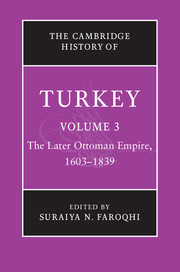Book contents
- Frontmatter
- PART I BACKGROUND
- PART II AN EMPIRE IN TRANSITION
- PART III THE CENTRE AND THE PROVINCES
- 7 The Ottoman centre versus provincial power-holders: an analysis of the historiography
- 8 Semi-autonomous provincial forces in the Balkans and Anatolia
- 9 Semi-autonomous forces in the Arab provinces
- PART IV SOCIAL, RELIGIOUS AND POLITICAL GROUPS
- PART V MAKING A LIVING
- PART VI CULTURE AND THE ARTS
- Glossary
- Bibliography
- Index
- References
8 - Semi-autonomous provincial forces in the Balkans and Anatolia
from PART III - THE CENTRE AND THE PROVINCES
Published online by Cambridge University Press: 28 March 2008
- Frontmatter
- PART I BACKGROUND
- PART II AN EMPIRE IN TRANSITION
- PART III THE CENTRE AND THE PROVINCES
- 7 The Ottoman centre versus provincial power-holders: an analysis of the historiography
- 8 Semi-autonomous provincial forces in the Balkans and Anatolia
- 9 Semi-autonomous forces in the Arab provinces
- PART IV SOCIAL, RELIGIOUS AND POLITICAL GROUPS
- PART V MAKING A LIVING
- PART VI CULTURE AND THE ARTS
- Glossary
- Bibliography
- Index
- References
Summary
Provincial elites as mediators
In the past, history writing on the Ottoman Empire tended to view the emergence of provincial forces as a challenge to central authority and therefore as a symptom of imperial decline. Historians drew mostly on source materials from the central state archives, such as the ‘justice decrees’ that had been issued in order to condemn predatory practices of rebellious administrators and bandits (celali) during the sixteenth to eighteenth centuries. Moreover, such research remained more or less focused on the ‘classical’ Ottoman regime, subscribing thereby rather uncritically to what the Weberian archetypical concept of ‘sultanism’ implied – that is, a kind of patrimonialism that left little room for negotiated solutions on the basis of popular acceptance. Thus early on it was rarely appreciated that a substantial group of provincial mediators between the ruler and the ruled existed, and even when taken note of, such persons’ reputation was tainted with corruption, many of them being branded as usurpers (mütegallibe). But in recent decades a more subtly differentiating approach in Ottoman studies has gained prevalence. It is by now recognised that, despite the ‘feudal’ divide between the ruling estate (askeri) and the tax-paying subjects (reaya), the provincial population was able to articulate its gravamina in a politically appropriate and effective manner. For example, petitioning was an important channel through which even the peasantry could reach the ear of the sultan and ask for a redress of grievances.
- Type
- Chapter
- Information
- The Cambridge History of Turkey , pp. 157 - 185Publisher: Cambridge University PressPrint publication year: 2006
References
- 7
- Cited by



